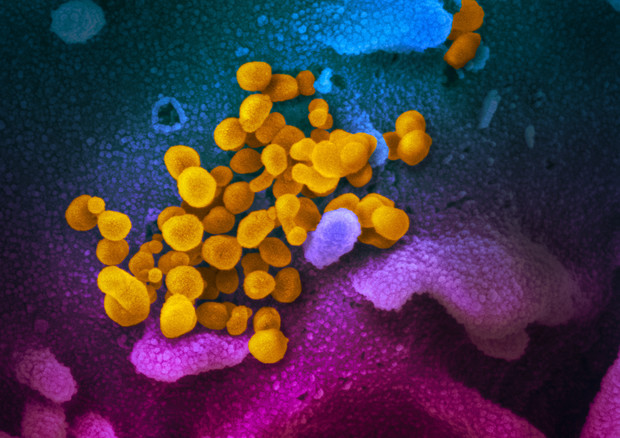Coronavirus, scoperta una nuova via con cui invade le cellule / Coronavirus, discovered a new way by which it invades cells
Coronavirus, scoperta una nuova via con cui invade le cellule / Coronavirus, discovered a new way by which it invades cells
Segnalato dal Dott. Giuseppe Cotellessa / Reported by Dr. Giuseppe Cotellessa

Particelle del coronavirus SarsCov2 sulla superficie di una cellula, ottenute dal Niaid / SarsCov2 coronavirus particles on the surface of a cell, obtained from Niaid (fonte: NIAID-RML)
Scoperta una nuova strada usata dal virus Sars-Cov-2 per entrare nella cellula umana, oltre a quella già nota del recettore Ace2: è il recettore dell'acido sialico, presente nei tessuti delle alte vie respiratorie e utilizzato allo stesso scopo anche dal virus della Mers.Una volta entrato, per replicarsi si serve di diverse proteine tra cui alcune in comune con il virus dell'Hiv. Lo indicano due studi dell'Istituto italiano di tecnologia su Arxiv. La scoperta apre a nuove ipotesi sulla sua contagiosita' e possibili farmaci da usare. Agli studi, che non hanno ancora superato il vaglio della comunità scientifica, ha collaborato l'Univrsità Sapienza di Roma.
"Abbiamo sviluppato un nuovo modello predittivo per capire come le proteine sulla superficie del virus interagiscono con i recettori umani", spiega Giancarlo Ruocco, direttore del centro Iit di Roma. Qui i ricercatori hanno analizzato le interazioni della proteina Spike, con cui il virus aggancia il recettore Ace2 (lo stesso preso come bersaglio dai farmaci sartani e anti-ipertensivi), e confrontato la sua capacità di rimanergli legata. Con sorpresa è emerso che questa capacità era molto inferiore a quella del virus della Sars.
Di qui l'idea di cercare un secondo recettore coinvolto. "Abbiamo così scoperto che per entrare nella cellula - prosegue Ruocco - il virus Sars-Cov-2 si serve anche dell'acido sialico, presente nelle alte vie respiratorie e utilizzato anche dal coronavirus responsabile della Mers". Ora bisognerà capire se la diversa mortalità e infettività del Covid-19 possa dipendere da queste due vie d'ingresso. "Ciò potrebbe chiarire - osserva - perché ci siano tanti casi asintomatici, ma questa è solo un'ipotesi che deve essere confermata,così come i risultati dello studio".
L'altra ricerca, coordinata da Gian Gaetano Tartaglia dell'Iit di Genova, ha scoperto che la parte della proteina Spike che interagisce con il recettore dell'acido sialico cambia molto tra i vari ceppi di virus, il che potrebbe spiegare le grandi differenze di comportamento del virus osservate nelle diverse popolazioni. Ha anche studiato come agisce il virus una volta dentro la cellula per riprodursi. "Abbiamo così visto che oltre a servirsi di alcune proteine già note e in comune con altri virus, ve ne sono altre specifiche. Di queste ultime, una decina sono condivise con il virus dell'Hiv", precisa Tartaglia. Il suggerimento dei ricercatori è quindi "di provare a usare, tra gli antivirali sviluppati in questi anni per l'Hiv, quelli che agiscono in modo mirato su queste proteine - conclude - Anche in questo caso i dati devono essere confermati, e speriamo che questa nostra pubblicazione faccia da passa parola scientifico e ci faccia arrivare commenti utili per capire".
ENGLISH
A new route used by the Sars-Cov-2 virus to enter the human cell has been discovered, in addition to the one already known from the Ace2 receptor: it is the sialic acid receptor, present in the tissues of the upper respiratory tract and used for the same purpose also by the virus Once entered, to replicate it uses different proteins including some in common with the HIV virus. Two studies by the Italian Institute of Technology on Arxiv indicate this. The discovery opens up new hypotheses about its contagiousness and possible drugs to use. The Sapienza University of Rome has collaborated in the studies, which have not yet passed the scrutiny of the scientific community.
"We have developed a new predictive model to understand how proteins on the surface of the virus interact with human receptors," explains Giancarlo Ruocco, director of the IIT center in Rome. Here the researchers analyzed the interactions of the Spike protein, with which the virus locks on the Ace2 receptor (the same one targeted by sartan and anti-hypertensive drugs), and compared its ability to remain linked to it. Surprisingly, this ability was much lower than that of the Sars virus.
Hence the idea of looking for a second receptor involved. "We have thus discovered that to enter the cell - continues Ruocco - the Sars-Cov-2 virus also uses sialic acid, present in the upper respiratory tract and also used by the coronavirus responsible for MERS". Now we will have to understand if the different mortality and infectivity of Covid-19 can depend on these two ways of entry. "This could clarify - he notes - why there are so many asymptomatic cases, but this is only a hypothesis that needs to be confirmed, as well as the results of the study".
The other research, coordinated by Gian Gaetano Tartaglia of the IIT of Genoa, found that the part of the Spike protein that interacts with the sialic acid receptor changes a lot between the various virus strains, which could explain the great differences of Virus behavior observed in different populations. He also studied how the virus acts once inside the cell to reproduce. "We have thus seen that in addition to using some proteins already known and in common with other viruses, there are other specific ones. Of the latter, a dozen are shared with the HIV virus," explains Tartaglia. The suggestion of the researchers is therefore "to try to use, among the antivirals developed in recent years for HIV, those that act in a targeted way on these proteins - he concludes - Also in this case the data must be confirmed, and we hope that this our publication is a scientific word of mouth and sends us useful comments to understand ".
Da:



Commenti
Posta un commento